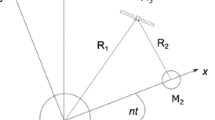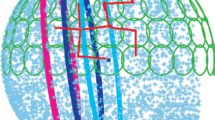Abstract
Thse powered aero-gravity-assist is an orbital maneuver that combines three basic components: a gravity-assist with a passage by the atmosphere of the planet during the close approach and the application of an impulse during this passage. The mathematical model used to simulate the trajectories is the Restricted Three-Body Problem including the terms coming from the aerodynamic forces. The present paper uses this type of maneuver considering that the trajectory of the spacecraft is in the ecliptic plane and the presence of the atmospheric Drag and Lift forces. The maneuver in the ecliptic plane can be done due to technologies that provides spacecraft with high values for the Lift to Drag ratio. The main advantage is that this maneuver allows the modification of the semi-major axis of the orbit of the spacecraft using the gravity of the planet and, at the same time, to change the inclination, using the high Lift that is perpendicular to the ecliptic plane. So, it is a combined maneuver that changes two important orbital parameters at the same time. The Lift is applied orthogonal to the initial orbital plane to generate an inclination change in the trajectory of the spacecraft, which is a very expensive maneuvers when made using propulsion systems. The Lift to Drag ratio used in the present paper goes up to 9.0, because there are vehicles, like waveriders, designed to have these values. When the spacecraft is passing by the periapsis of its orbit, an instantaneous impulse is applied to increase or decrease the variation of energy given by the aero-gravity-assist maneuver. The planets Venus and Mars are selected to be the bodies for the maneuver, due to their atmospheric density and strategic location in the Solar System to provide possible uses for future missions. Results coming from numerical simulations show the maximum changes in the inclination obtained by the maneuvers, as a function of the approach angle and direction of the impulse; the Lift to Drag ratio and the ballistic coefficient. In the case of Mars, inclination changes can be larger than 13°, and for Venus larger than 21°. The energy and inclination variations are shown for several selected orbits. The powered aero-gravity-assist maneuver generates inclination changes that are higher than the ones obtained from the powered maneuver and/or the aero-gravity maneuver.
















Similar content being viewed by others
References
Armellin, R., Lavagna, M., Ercoli-Finzi, A.: Aero-gravity assist maneuvers: controlled dynamics modeling and optimization. Periodic. Quasi-Periodic and Chaotic Motions in Celestial Mechanics: Theory and Applications. 391–405 (2006)
Armellin, R., Lavagna, M., Starkey, R., Lewis, M.: Aerogravity-assist maneuvers: coupled trajectory and vehicle shape optimization. J. Spacecr. Rocket. 44(5), 1051–1059 (2007)
Broucke, R.A.: The celestial mechanics of gravity assist. In: AIAA/AAS Astrodynamics Conference, Minneapolis, MN, August (1988) (AIAA paper 88–4220). https://doi.org/10.2514/6.1988-4220
Casalino, L., Colasurdo, G., Pastrone, D.: Simple strategy for powered swing-by. J. Guid. Control. Dyn. 22(1), 156–159 (1999a)
Casalino, L., Colasurdo, G., Pasttrone, D.: Optimal low-thrust scape trajectories using gravity assist. J. Guid. Control. Dyn. 22(5), 637–642 (1999b)
D’Amario, L.A., Byrnes, D.V., Stanford, R.H.: A new method for optimizing multiple-flyby trajectories. J. Guid. Control. Dyn. 4, 591–596 (1981). https://doi.org/10.2514/3.56115
D’Amario, L.A., Byrnes, D.V., Stanford, R.H.: Interplanetary trajectory optimization with application to Galileo. J. Guid. Control. Dyn. 5, 465–471 (1982). https://doi.org/10.2514/3.56194
Deerwester, J.: Jupiter Swingby missions to the outer planets. J. Spacecr. Rocket. 3(10), 1564–1567 (1966)
Elices, T.: Maximum Delta-V in the aerogravity assist maneuver. J. Spacecr. Rocket. 32(5), 921–922 (1995)
Ferreira, A.F., Prado, A.F.B.A., Winter, O.C., Santos, D.P.S.: Effects of the eccentricity of the primaries in a powered swing-by maneuver. Adv. Space. Res. 59(8), 2071–2087 (2017a). https://doi.org/10.1016/j.asr.2017.01.033
Ferreira, A.F., Prado, A.F.B.A., Winter, O.C.: A numerical mapping of energy gains in a powered swing-by maneuver. Nonlinear Dyn. 89(2), 791–818 (2017b). https://doi.org/10.1007/s11071-017-3485-2 To be published
Ferreira, A.F.S., Prado, A.F.B.A., Winter, O.C.: A numerical study of powered swing-Bys around the moon. Adv. Space Res. 56, 252–272 (2015). https://doi.org/10.1016/j.asr.2015.04.016
Flandro, G.: Fast reconnaissance missions to the outer solar system utilizing energy derived from the gravitational field of Jupiter. Earth. 108, 1–6 (1966)
Gomes, V., Piñeros, J., Prado, A., Golebiewska, J.: Atmospheric close approaches with the earth considering drag and lift forces. J. Comput. Appl. Math. 35, 817–833 (2016). https://doi.org/10.1007/s40314-015-0256-x
Gomes, V.M., Prado, A.F.B.A.: Swing-by maneuvers for a cloud of particles with planets of the solar system. WSEAS Transactions on Applied and Theoretical Mechanics. 3(11), 869–878 (2008)
Grard, R.: Mercury: the messenger and BepiColombo missions a concerted approach to the exploration of the planet. Adv. Space Res. 38, 563 (2006). https://doi.org/10.1016/j.asr.2006.06.015
Henning, G., Edelman, P., Longuski, M.: Design and optimization of interplanetary aerogravity-assist tours. J. Spacecr. Rocket. AIAA. 51, 1849–56, 1856 (2014)
Hollister, W.M., Prussing, J.E.: Optimum transfer to Mars via Venus. Thermophysics Specialist Conference, Fluid Dynamics and Co-located Conferences. (1966). https://doi.org/10.2514/6.1965-700
Johnson, W., Longuski, J.: Design of aerogravity-assist trajectories. J. Spacecr. Rocket. 39(1), 23–30 (2002)
Lavagna, M., Povoleri, A., Finzi, A.: Interplanetary mission design with aero-assisted manoeuvres multi-objective evolutive optimization. Acta Astronaut. 57(2), 498–509 (2005)
Lewis, M., McRolnald, A.: Design of hypersonic waveriders for aeroassited interplanetary trajectories. J. Spacecr Rocket. AIAA. 29–25 (1992)
Lohar, A., Mateescu, D., Misra, K.: Optimal atmospheric trajectory for aero-gravity assist. Acta Astronaut. 32–32 (1994). https://doi.org/10.1016/0094-5765(94)90059
Lohar, A., Misra, K., Mateescu, D.: Mars-Jupiter Aerogravity assist trajectories for high-energy missions. J. Spacecr. Rocket. 34(1), 16–21 (1997). https://doi.org/10.2514/2.3186
Mazzaracchio, A.: Flight-path guidance for aerogravity-assit maneuvers on hyperbolic trajectories. J. Guid. Control Dynam. AIAA. 38(2), (2015)
McNutt Jr., R.L., Solomon, S.C., Gold, R.E., Leary, J.C.: The messenger mission to mercury: development history and early mission status. Adv. Space Res. 38, 564–571 (2006). https://doi.org/10.1016/j.asr.2005.05.044
McNutt Jr., R.L., Solomon, S.C., Grard, R., Novara, M., Mukai, T.: An international program for mercury exploration: synergy of messenger and Bepicolombo. Adv. Space Res. 33, 2126–2132 (2004). https://doi.org/10.1016/S0273-1177(03)00439-3
Murcia, J.O., Prado, A.F.B.A., Gomes, M.: Retrograde and Direct Powered Aero-Gravity-Assist Trajectories around Mars. Rev. Mex. Astron. Astrofís. 54, 143–161 (2018)
Negri, R.B., Prado, A.F.B.A., Sukhanov, A.: Studying the errors in the estimation of the variation of energy by the “patched-conics” model in the three-dimensional swing-by. Celest. Mech. Dyn. Astron. 129(3), 269–284 (2017). https://doi.org/10.1007/s10569-017-9779-3
Niehoff, J.C.: Gravity-assisted trajectories to solar-system. J. Spacecr. Rocket. 3(9), 1351–1356 (1966)
Piñeros, J.O.M., Prado, A.F.B.A.: Powered aero-gravity-assist maneuvers considering lift and drag around the earth. Astrophys. Space Sci. 362(7), 120 (2017)
Prado, A.F.B.A.: Close-approach trajectories in the elliptic restricted problem. J. Guid. Control. Dyn. 20, 797–802 (1997). https://doi.org/10.2514/2.4115
Prado, A.F.B.A.: A comparison of the “patched-conics approach” and the restricted problem for swing-bys. Adv. Space Res. 40, 113–117 (2007)
Prado, A.F.B.A.: Powered swing-by. J. Guid. Control. Dyn. 19(5), 1142–1147 (1996). https://doi.org/10.2514/3.21756
Prado, A.F.B.A., Broucke, R.A.: Effects of atmospheric drag in swing-by trajectory. Acta Astronaut. 36(6), 285–290 (1995)
Rao, A., Scherich, A., Cox, S., Mosher, T.: A concept for operationally responsive space mission planning using aeroassisted orbital transfer. In: 2008 Responsive Space Conference (2008)
Santos, D.P.S., Prado, A.F.B.A., Casalino, L., Colasurdo, G.: Optimal trajectories towards near-earth-objects using solar electric propulsion (sep) and gravity assisted maneuver. J. Aerosp Eng. Sci. Appl. 1(2), 51–64 (2008)
Silva, A.F., Prado, A.F.B.A., Winter, O.C.: Powered swing-by maneuvers around the moon. J. Phys. Conf. Ser. 465, 012001 (2013). https://doi.org/10.1088/1742-6596/465/1/012001
Sims, J., Longuski, J., Patel, M.: Aerogravity-assist trajectories to the outer planets and the effect of drag. J. Spacecr. Rocket. 37(1), 49–55 (2000)
Szebehely, S.: Theory of Orbits the Restricted Problem of Three Bodies. Academic Press, New York (1967)
Acknowledgments
The authors wish to express their appreciation for the support provided by grants # 406841/2016-0 and 301338/2016-7 from the National Council for Scientific and Technological Development (CNPq); grants # 2016/24561-0 and 2016/14665-2, from São Paulo Research Foundation (FAPESP) and the financial support from the National Council for the Improvement of Higher Education (CAPES).
Author information
Authors and Affiliations
Corresponding author
Additional information
Publisher’s Note
Springer Nature remains neutral with regard to jurisdictional claims in published maps and institutional affiliations.
Rights and permissions
About this article
Cite this article
Murcia-Piñeros, J.O., Prado, A.F.B.A. Application of Impulsive Aero-Gravity Assisted Maneuvers in Venus and Mars to Change the Orbital Inclination of a Spacecraft. J of Astronaut Sci 66, 322–340 (2019). https://doi.org/10.1007/s40295-019-00156-5
Published:
Issue Date:
DOI: https://doi.org/10.1007/s40295-019-00156-5




